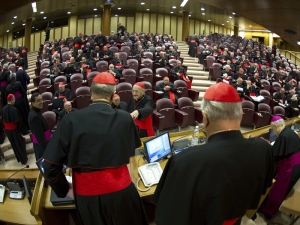

Cardinals begin papal election with inconclusive vote
Bellevision Media Network
Vatican City, 13 Mar 2013 (AFP) : Cardinals held a first inconclusive vote in the Sistine Chapel today as they began the process of electing a successor to Benedict XVI, with tens of thousands of people packed into St Peter’s Square to watch the time-honoured tradition.
The crowd cheered as black smoke billowed into the night air above the Vatican from a thin copper chimney on the chapel’s roof, indicating that no pope had been elected.
 The eyes of the world will be fixed on the chimney in the coming days for the smoke signals sent out twice daily -- white smoke will indicate that a new leader of the world’s 1.2 billion Catholics has been chosen.
The eyes of the world will be fixed on the chimney in the coming days for the smoke signals sent out twice daily -- white smoke will indicate that a new leader of the world’s 1.2 billion Catholics has been chosen.
The 115 cardinals filed past Swiss Guards into the chapel earlier on Tuesday chanting the Latin hymn "Veni Creator Spiritus" ("Come Creator Spirit") to ask for divine guidance after Benedict’s troubled eight-year papacy.
The scarlet-robed "Princes of the Church" swore on the Bible never to reveal the secrets of their deliberations or face being cast out of the Church, before the chapel’s heavy wooden doors swung shut to indicate the lock-in had begun.
The chapel has been swept for bugs and installed with jamming devices to prevent electronic communications, leaving cardinals entirely cut off from the outside world behind the Vatican’s walls until they have elected a new pontiff.
At an extravagant pre-conclave mass in St Peter’s Basilica the cardinals prayed for unity in the Church -- a stark reminder of the infighting that often overshadowed Benedict’s eight-year reign.
As rainstorms drenched pilgrims outside, the cardinals burst into thunderous applause when the dean of the College of Cardinals, Angelo Sodano, thanked the "beloved and venerable" Benedict.
On the Vatican’s 17th-century plaza, a barefoot pilgrim in a sackcloth habit knelt on the cobblestones in the pouring rain and bowed his head in prayer as the chants from the mass echoed across the square from four giant screens.
"Without a pope I feel bereft, like an orphan," said French priest Guillaume Le Floch, 35.
"The Church needs a great leader now more than ever. The cardinals have a chance to astonish us."
The smoke from the Sistine Chapel is produced by burning the ballots in a special stove and adding artificial smoke, the Vatican engineer in charge of preparing the chapel, Paolo Sagretti, told AFP.
"We use smoke flares," he said. After several episodes in which greyish smoke that could be interpreted as white or black created confusion, the Vatican introduced the surer system starting with the last conclave in 2005.
Modern-day conclaves normally last no more than a few days and a two-thirds majority is required.
The longest conclave in the past century lasted five days, in 1922. Benedict’s election in 2005 following John Paul’s death took just two days.
Three cardinals have emerged as favourites -- Italy’s Angelo Scola, Brazil’s Odilo Scherer and Canada’s Marc Ouellet.
Like "pope emeritus" Benedict XVI, all of them combine conservative views with social advocacy on issues like poverty, conflict and immigration.
All the cardinals were appointed either by Benedict or John Paul II.
But cardinals from Austria, Hungary, Mexico, the Philippines, South Africa and the United States -- some of them with more reformist outlooks -- were also rumoured to be in contention.
Bookmakers said Scola was the favourite, followed by Ghana’s Peter Turkson and Scherer.
Mexican Cardinal Norberto Rivera Carrera told Italian daily La Stampa there was no pre-conclave consensus.
"Some imagine him to be more academic, able to establish a dialogue with culture. Others ask for someone who is close to the people. Others still want someone with more authority to put some Church problems in order," he said.
"So far, there is no majority."
A few key aims unite many of the cardinals, such as reforming the intrigue-ridden Vatican bureaucracy and re-igniting Catholic faith in the way the charismatic John Paul II did.
There have been calls too from within the Church for a rethink of some basic tenets such as priestly celibacy, the uniform ban on artificial contraception and even allowing women to be priests as in other Christian denominations.
The tradition of holding conclaves dates back to 1268 when cardinals were locked into the papal palace in Viterbo near Rome by an angry crowd because they were taking too long to choose a pope.
Their conclave still dragged on for three years. Italian media reported the cardinals will be served plain but wholesome food at their Vatican residence -- where the windows are locked shut and telephones are for internal use only.